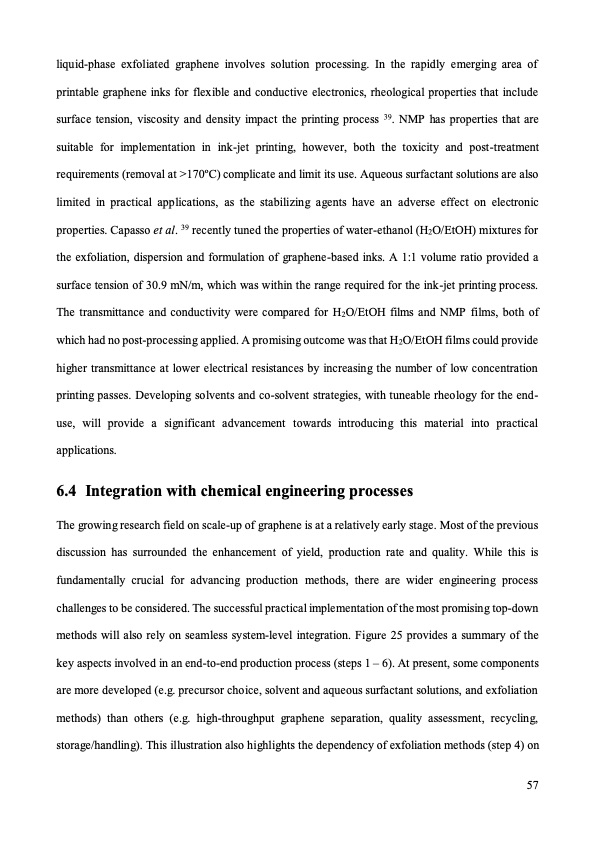
PDF Publication Title:
Text from PDF Page: 057
liquid-phase exfoliated graphene involves solution processing. In the rapidly emerging area of printable graphene inks for flexible and conductive electronics, rheological properties that include surface tension, viscosity and density impact the printing process 39. NMP has properties that are suitable for implementation in ink-jet printing, however, both the toxicity and post-treatment requirements (removal at >170oC) complicate and limit its use. Aqueous surfactant solutions are also limited in practical applications, as the stabilizing agents have an adverse effect on electronic properties. Capasso et al. 39 recently tuned the properties of water-ethanol (H2O/EtOH) mixtures for the exfoliation, dispersion and formulation of graphene-based inks. A 1:1 volume ratio provided a surface tension of 30.9 mN/m, which was within the range required for the ink-jet printing process. The transmittance and conductivity were compared for H2O/EtOH films and NMP films, both of which had no post-processing applied. A promising outcome was that H2O/EtOH films could provide higher transmittance at lower electrical resistances by increasing the number of low concentration printing passes. Developing solvents and co-solvent strategies, with tuneable rheology for the end- use, will provide a significant advancement towards introducing this material into practical applications. 6.4 Integration with chemical engineering processes The growing research field on scale-up of graphene is at a relatively early stage. Most of the previous discussion has surrounded the enhancement of yield, production rate and quality. While this is fundamentally crucial for advancing production methods, there are wider engineering process challenges to be considered. The successful practical implementation of the most promising top-down methods will also rely on seamless system-level integration. Figure 25 provides a summary of the key aspects involved in an end-to-end production process (steps 1 – 6). At present, some components are more developed (e.g. precursor choice, solvent and aqueous surfactant solutions, and exfoliation methods) than others (e.g. high-throughput graphene separation, quality assessment, recycling, storage/handling). This illustration also highlights the dependency of exfoliation methods (step 4) on 57PDF Image | graphene production via nonoxidizing liquid exfoliation

PDF Search Title:
graphene production via nonoxidizing liquid exfoliationOriginal File Name Searched:
Graphene-R2-review.pdfDIY PDF Search: Google It | Yahoo | Bing
Salgenx Redox Flow Battery Technology: Power up your energy storage game with Salgenx Salt Water Battery. With its advanced technology, the flow battery provides reliable, scalable, and sustainable energy storage for utility-scale projects. Upgrade to a Salgenx flow battery today and take control of your energy future.
| CONTACT TEL: 608-238-6001 Email: greg@infinityturbine.com | RSS | AMP |